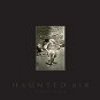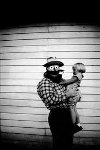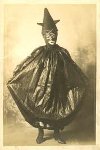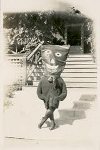 The dream of time travel has been achieved with the spectral photographs presented in this book, a collection of anonymous Hallowe'en pictures from America circa the years 1875 through 1955. Bound in soft black cloth the pages inside are windows onto the ghost memories of America, captured in the twilight years before the Hallowe'en had become fodder for a Hallmark industry churning out cards, candy and plastic decorations. This assemblage of photos portraying kids and adults dressed up as ghosts, witches, scarecrows, skeletons, animals, monsters, and stranger inexplicable beings shows unequivocally the thin line between life and death, reverence and revelry the day is known for. In bringing them all together some of Hallowe'ens primal atavism is restored.
The dream of time travel has been achieved with the spectral photographs presented in this book, a collection of anonymous Hallowe'en pictures from America circa the years 1875 through 1955. Bound in soft black cloth the pages inside are windows onto the ghost memories of America, captured in the twilight years before the Hallowe'en had become fodder for a Hallmark industry churning out cards, candy and plastic decorations. This assemblage of photos portraying kids and adults dressed up as ghosts, witches, scarecrows, skeletons, animals, monsters, and stranger inexplicable beings shows unequivocally the thin line between life and death, reverence and revelry the day is known for. In bringing them all together some of Hallowe'ens primal atavism is restored.

Each of these photographs tells a story. When I look into any one of them I feel I have become a witness to a way of life that is at once dying, and in certain corners of society, is being born again. Here the old life of the holiday is preserved. It looks very different from the Halloween I grew up with, which was in the process of removing itself from being a festival of death to a festival of pop culture. Few are the ghosts and ghouls who trick or treat these days. Most of the costumes that kids wear now are culled from a lexicon of cartoons and hollywood movies. While these do have their origin in the imagination (someone gave birth to the plethora of characters emerging from screen after all) in my mind it is an imagination that has been tainted. The costumes come prepackaged like so much else in our contemporary world, ready to be pulled off the shelf. These pictures are populated by spirits from the collective imagination of the Celtic folk who brought the holiday over to the New World. In his historic note at the end of the book Ossian writes, "Fleeing Ireland's Great Famine of 1845, many thousands crossed the Atlantic to America. The haunted tradition they carried with them would quickly take root and flourish in the fertile soil of the New World. Feeding hungrily on fresh lore, consuming half-remembered tales of its own shadowy origins and rituals, Hallowe'en was reborn. New blood—Scandinavian, Germanic, African, Native-American—flowed in its veins spawning a host of hybrid phantoms to consult, to confront, to placate." These phantoms from other cultures have certainly enriched the holiday. But
as consumer culture continued to amp up in the suburbs during the latter half of the fifties some of its original lifeblood begin to be drained out of it. Witness Halloween's remains: foppish vampires trying to be sexy, mobs of marauding zombies loitering in the malls (without the irony of George R. Romero), people with their skin painted blue to imitate the Na'vi, an exscuse to be raunchy and dress in the most provocative fashion. These photos, of kids who have paper bags over their heads with large teeth drawn on them, of a lady who has dozens of spoons attached to a black dress, of paper machied devil masks, of little girls in white dresses wearing a homespun cat mask, preserve a window of time when Hallowe'en was perhaps more innocent—but also much more monstrous and genuinely scary.

The ancient Celts called it Samhain and it was their new year, the beginning of the dark half of the year, a time when the veils of this world and the Otherworld thinned, and when spirits could stray forth from one to the other. It was a time for honoring the ancestors and the beloved dead who had already moved on from this physical world. These pictures capture the remnants of those beliefs, still hanging on alongside the dominant religion, captivating the imagination of the people, still carrying a sense of soul even as industry marched forward to an ascendant position, enthroning a blind materialist reductionism where before there had been mystery. People wore the masks they did and gathered together to celebrate, as a way of grinning back at death, as a way of looking into the darkness with a smile, to reaffirm on one wild night their place among the living. The demonic, ghostly, and spiritual aspects are still there to some degree, lingering on, while the «festival's lawless, intoxicating spirit» lives in the many debauched and drunken parties held around October 31. The sense of mystery is largely absent in Halloween's popular, contemporary incarnation, and is its greatest casualty.
To look at these photos is to take a walk into the past, down blue highways into the heartlands of what Harry Smith has called the "old weird America." Life in the small towns and rural backwoods shown among these pages wasn’t always quaint and these pictures speak of the mischief known to take place on Halloween night: the loosening of the moral belt (even in an Appalachia beholden to the bible). Ossian writes, "Gates were hung in trees and trucks overturned; livestock loosed; fires lit, tricks played and treats demanded." My own maternal grandfather, a country music playing man of Irish descent, grew up in the hollers of Kentucky. He recounted as much to me of his own Halloween wickedness, telling me tales, with only some regret, of the damage he had done to neighboring farms, of outhouses overturned and other boyhood exploits. Something of the nights wildness spoke from his eye when he told me these things. When the spirits are loosed for the night, so people abandoned themselves and the laws normally governing their behavior. A number of these photos show the potential for rural mischief. A group of people pose in a wagon, bonnets above the faces of the masked women, a man perched on top pointing a shotgun at some unknown threat. A shack sits in the background next to scraggly trees.

The book itself is dedicated to Jhon Balance. Like the music of Coil and Cyclobe (the latter of which Ossian is a founding member of) these photos open up sleeping corners of the brain and awaken collective memory. David Lynch provides a few introductory paragraphs where he writes of his first experiences seeing the collection for the first time. In his characteristic sparse prose Lynch shares his experience of looking at them, cappuccino and cigarette at hand, "I was somewhere else. I thought I was someplace but now I didn't know what place. I seemed to be inside foreign worlds where there was some kind of troubling camaraderie. ...They seemed to have a glee for somehow stitching a laugh to darkness."
The prose of Geoff Cox is florid and elaborate, like the calligraphy he is also known for—as Geoff Cox-Doree—on Current 93 albums The Inmost Light and Black Ships Ate the Sky. (Cox also plays on the Tibet-Stapleton album The Sadness of Things.) His capable pen transforms the pictures into poetry, "family portraits, mementoes of the treasured, the held dear-in-heart, now unrecognisable, other. Torn from album pages, sold piecemeal for pennies and scattered, abandoned to melancholy chance and the hands of strangers. Frayed by forgetting, they are homeless ghosts..." but here in Haunted Air they have found a home at last.